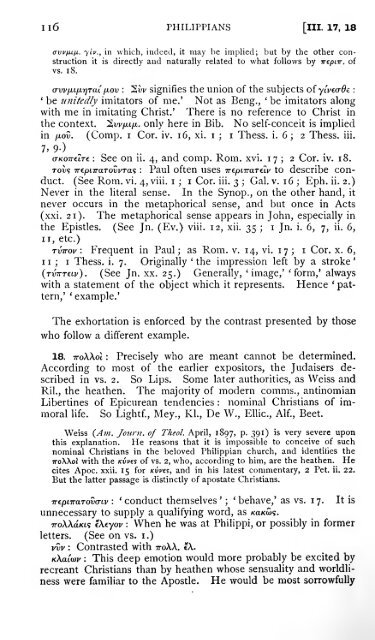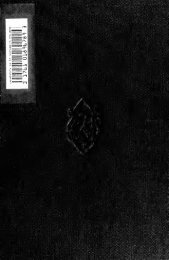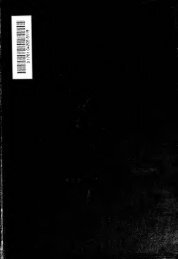Philippians and Philemon - MR Vincent - 1906.pdf
Philippians and Philemon - MR Vincent - 1906.pdf
Philippians and Philemon - MR Vincent - 1906.pdf
Create successful ePaper yourself
Turn your PDF publications into a flip-book with our unique Google optimized e-Paper software.
Il6 PHILIPPIANS [ill. 17, 18<br />
.yiv., in which, indeed, it may be impHed; but by the other construction<br />
it is directly <strong>and</strong> naturally related to what follows by . of<br />
vs. i8.<br />
: 2 signifies the union of the subjects :<br />
' be tmitedly imitators of me.' Not as Beng., ' be imitators along<br />
with me in imitating Christ.' There is no reference to Christ in<br />
the context. '. only here in Bib. No self-conceit is implied<br />
in . (Comp. i Cor. iv. i6, xi. i ; i Thess. i. 6 ; 2 Thess. iii.<br />
7' 9•)<br />
7££ :<br />
See on ii. 4, <strong>and</strong> comp. Rom. xvi. 1752 Cor. iv. 18.<br />
TOiis/: Paul often uses to describe con-<br />
duct. (See Rom. vi. 4, viii. i ; i Cor. iii. 3 ; Gal. v. 16 ; Eph. ii. 2.)<br />
Never in the literal sense. In the Synop., on the other h<strong>and</strong>, it<br />
never occurs in the metaphorical sense, <strong>and</strong> but once in Acts<br />
(xxi. 21). The metaphorical sense appears in John, especially in<br />
the Epistles. (See Jn. (Ev.) viii. 12, xii. 35 ; i Jn. i. 6, 7, ii. 6,<br />
II, etc.) / : Frequent in Paul; as Rom. v. 14, vi. 17 ; i Cor. x. 6,<br />
11; I Thess. i. 7. Originally ' the impression left by a stroke<br />
(). (See Jn. XX. 25.)<br />
Generally, 'image,' 'form,' always<br />
with a statement of the object which it represents. Hence * pattern,'<br />
' example.'<br />
The exhortation is enforced by the contrast presented by those<br />
who follow a different example.<br />
18. : Precisely who are meant cannot be determined.<br />
According to most of the earlier expositors, the Judaisers described<br />
in vs. 2. So Lips. Some later authorities, as Weiss <strong>and</strong><br />
Ril., the heathen. The majority of modern comms., antinomian<br />
Christians of im-<br />
Libertines of Epicurean tendencies :<br />
moral life.<br />
nominal<br />
So Lightf , Mey., Kl., De W., Ellic, Alf., Beet.<br />
Weiss (^Am. Jotirii. of Theol. April, 1897, P• 390<br />
^^ very severe upon<br />
this explanation. He reasons that it is impossible to conceive of such<br />
nominal Christians in the beloved Philippian church, <strong>and</strong> identifies the<br />
KoKKol with the%of vs. 2, who, according to him, are the heathen. He<br />
cites Apoc. xxii. 15 for KUves, <strong>and</strong> in his latest commentary, 2 Pet. ii. 22.<br />
But the latter passage is distinctly of apostate Christians.<br />
'<br />
: conduct themselves ' '<br />
; behave,' as vs.<br />
unnecessary to supply a qualifying word, as.<br />
1 7. It is<br />
eXeyov : When he was at Philippi, or possibly in former<br />
letters. (See on vs. i.)<br />
: Contrasted with. t\.<br />
: This deep emotion would more probably be excited by<br />
recreant Christians than by heathen whose sensuality <strong>and</strong> worldliness<br />
were familiar to the Apostle. He would be most sorrowfully<br />
'





